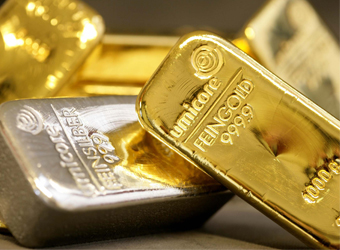Gold futures inched lower on Thursday, retreating from the one-week high notched a day earlier, but the contract remained confined to the tight trading range seen over the last several sessions, as U.S. stocks drifted lower and the dollar stabilized.
June gold fell $9.40, or 0.7 percent, to $1,344 an ounce. It settled Wednesday at $1,353.50, the highest since April 11, according to FactSet data.
“Gold is quiet again … and remains stuck in a range between $1,300 and $1,365,” said Colin Cieszynski, chief market strategist at SIA Wealth Management Inc. “Traders appear to be taking comments out of the White House related to meetings with North Korea as positive and easing political risks.” That dulls haven demand for gold.
“The bigger story in precious metals … is that silver is starting to play catch up,” said Cieszynski. Last month, gold prices gained 0.7 percent, while silver prices fell by roughly 0.9 percent.
May silver gave up 10 cents, or 0.6 percent, to $17.15 an ounce Thursday after jumping by 2.8 percent in the previous session.
Trading in the dollar provided few directional hints for dollar-denominated precious metals. On Thursday, the ICE U.S. Dollar Index was up by about 0.2 percent at 89.67, trading around 0.1 percent lower week to date.
Gold has been mostly rangebound so far this year, absent catalysts that, according to analysts, might include a spike in inflation or a more-aggressive Federal Reserve response with higher interest rates, factors that would be expected to lift the dollar and depress gold prices.
Among Fed officials who spoke at recent events, Federal Reserve Gov. Randal Quarles on Wednesday said the recent flattening yield curve is not a signal that the nine-year-long U.S. economic expansion is approaching its end. Federal Reserve Board Governor Lael Brainard said Thursday that there are “some signs of financial imbalances in the economy.”
In economic data, U.S. weekly jobless claims fell slightly to 232,000. The Philadelphia Fed’s manufacturing index edged up 1 point to 23.2 in April and the leading economic index rose 0.3 percent in March—the smallest increase since last September.
Benchmark U.S. stock indexes headed lower, though remained stocks on course for weekly gains on the back of enthusiasm over first-quarter earnings. The S&P 500 components are expected to see earnings growth of 17.3 percent for the period, the fastest rate of expansion since 2011 and helping to dull demand for less-risky assets including metals.
Prices for nickel and aluminum traded in London, meanwhile, extended their rally to multiyear highs, driven by the news around Russian sanctions.
Nickel prices hit their highest level since December 2014, on concerns that Russian nickel producer Norilsk Nickel will be included under U.S. sanctions on Moscow that have already led to a rally in aluminum prices.
Moscow, meanwhile, has filed an official complaint to the World Trade Organization, arguing that the 25 percent tariff on steel, and 10 percent on aluminum, are “safeguard measures” meant to protect the U.S. economy and not as a boost to national security, the Guardian reported.
Elsewhere in the metals market, May copper traded at $3.132 a pound, down 0.8 percent. July platinum shed 0.4 percent to $942.50 an ounce, while June palladium lost 1.4 percent to $1,020.35 an ounce. It settled Wednesday at the highest level since late February, with the recent gains tied to U.S. tensions with Russia.
The SPDR Gold Shares exchange-traded fund slipped 0.2 percent, and the iShares Silver Trust advanced 0.4 percent, while the VanEck Vectors Gold Miners rose 0.3 percent.
Source: MarketWatch



